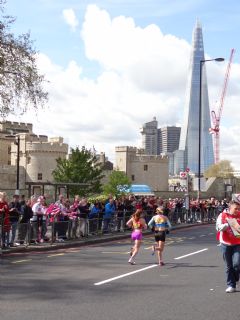For some of you, the goals for the year will revolve around some form of training or competition. For example, my good chum Steve (White) is already recruiting a crack team to take on the Edinburgh Moon Walk after last year's success, my super fit friend, Terri (Nolan), has decided that her debut in British National Bodybuilding Federation competition will come later this year (actually no point in anyone else turning up unless they're bothered about scrapping it out for a silver medal), my crazy pal, Matt (Graham), is gearing up for his white collar boxing bouts in Edinburgh in April & the Canadienne engineering whizz, that is Reva (Vaze), is contemplating the Rome half marathon.
It is, therefore, no surprise that over the last couple of weeks the number of people asking me about barefoot running has spiked once again. Several inquisitors have read Born to Run over Christmas & others have spoken to other would be running competitors whom have mentioned the approach. So in order to present you with some facts & a little bit of background reading on the topic, here are some recent studies that have been published in the field.
This paper looks at the collision forces recorded by barefoot runners (or those choosing minimalist shoes) in comparison to runners wearing more conventional footwear & relates the reduction in collision force (with the ground, obviously) in the barefoot group to a common forefoot strike seen in this population. This technique entails the foot being more plantarflexed on strike with greater ankle compliance, thus decreasing the effective body mass on ground collision.
This study assesses the differences in running economy between those wearing minimalist shoes in comparison to conventional running shoes & concluded that a modest but significant reduction in running economy is observed in those wearing minimalist footwear. The authors consider whether this difference can be related to a greater elastic energy storage & release in the lower extremity in the minimal-shoe running gait.
Daoud at al investigate the injury rate of those adopting a fore-foot strike in comparison to those who habitually rear-foot strike. The authors report a significantly higher rate of stress related injury presentations in those athletes who habitually rear-foot strike & hypothesise that this may be related to the absence of a marked impact peak in ground reaction force in the fore-foot striking population.
Altman & Davis review the current & previous research comparing conventional running shoes with barefoot or minimalist-footwear shod running in an attempt to establish the implications on running injuries. The main point to note is that the authors conclude that much more research is needed in the field.
Whilst these abstracts appear to suggest that barefoot running has a relationship to running economy & injury presentation, it must be noted that the first three papers are all co-authored by the same group. It is unclear as to their interests & their biases. Whereas the final review paper that fails to draw such conclusive evidence is authored by a different group.
What is clear, is that speaking as a clinician, an increased rate of injury presentation occurs when recreational athletes switch from running in a conventional shoe to training in minimalist style footwear without first seeking advice or coaching. The switch from one style of running to the other demands a lower extremity conditioning programme & a graduated approach to introducing mileage in the new training shoes.
A poorly executed transition is more than likely doomed to end any well-meaning fitness-based resolution before it has gotten beyond the beginning!!!

